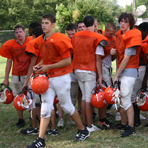 Blowing cool, dry air through football shoulder pads reduces the risk of heat illness in football players by reducing core body temperature and heart rate dramatically, according to a 2008 study by researchers at the University of Florida.
Blowing cool, dry air through football shoulder pads reduces the risk of heat illness in football players by reducing core body temperature and heart rate dramatically, according to a 2008 study by researchers at the University of Florida.
The study found that air forced under the uniform, rather than misted, cool air blown on to the uniform, could be a helpful measure to avoid heat-related illness in football players.
Funded by a grant from NFL Charities, the study represented a novel advancement in the pursuit of methods to decrease the incidence of heat related illness. "Heat stroke in football players has unfortunately been brought to national attention following the deaths of five football players between 2001 and 2004," said lead author Mary Beth Horodyski, EdD, Associate Professor and Director of Research for the Department of Orthopedics and Rehabilitation at the College of Medicine at the University of Florida. "We wanted to look at this new technology for cooling the athlete by blowing cool, dry air underneath their uniform to see how it would affect body temperature and heart rate."
Heat-related illness happens when the systems used by the body to regulate heat become overwhelmed and cannot compensate. Under these conditions, heat and body temperature climbs uncontrollably. Since 1995, 31 football players have died from heat stroke (23 high school, 5 college, and 2 professional, and one sandlot*). So far during the summer of 2011, the media has reported the deaths of five athletes and one coach from heat stroke.
The study monitored 15 athletes wearing shoulder pads, shorts and football helmets who participated in two testing sessions: on one day no air was blown under their shoulder pads and on another day cool, dry air was blown under the shoulder pads during rest periods and the recovery session. Three, 15-minute exercise cycles, separated by 10-minute rest periods were followed by a 20-minute recovery session. The exercise cycles consisted of jogging and sprinting on a treadmill in a room with a heat index of approximately 92 degrees Fahrenheit.
The study found that on the testing session day when the athletes had the cool, dry air blown under their shoulder pads, there was as much as 1 degree Fahrenheit reduction in core body temperature. The most dramatic difference in core body temperature was during the third recovery period. The athletes' average core body temperature was 100.3 degrees Fahrenheit for the cool dry air testing sessions, but for the same time period the average core body temperature was 101.7 degrees Fahrenheit without the cool dry air.
Additionally, with the cool, dry air the athletes had a significantly lower heart rate of about 8 to 10 beats per minute than without the cool, dry air.
"Obviously when the air was blown underneath the uniforms, the athletes benefited," said Dr. Horodyski. "Any small amount of reduction in core body temperature and decrease in heart rate could be the difference between an athlete suffering a heat-related illness or not. We need to continue investigating new technology such as this to prevent heat illness."
"It is important to note, however, that the technique is designed to prevent heat illness. It is not designed to treat a heat stroke," said Susan Yeargin, Ph. D., ATC, an Assistant Professor in the Applied Medicine and Rehabilitation Department at Indiana State University and MomsTeam heat illness expert.
The American Orthopaedic Society for Sports Medicine (AOSSM) is a world leader in sports medicine education, research, communication and fellowship, and includes national and international orthopaedic sports medicine leaders. The Society works closely with many other sports medicine specialists, including athletic trainers, physical therapists, family physicians, and others to improve the identification, prevention, treatment, and rehabilitation of sports injuries.








